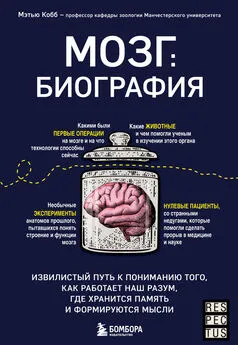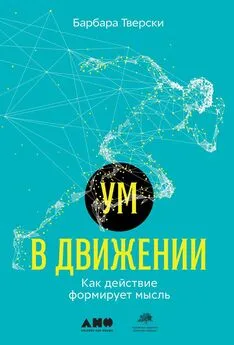Барбара Тверски - Ум в движении [Как действие формирует мысль] [litres]
- Название:Ум в движении [Как действие формирует мысль] [litres]
- Автор:
- Жанр:
- Издательство:Литагент Альпина
- Год:2020
- Город:Москва
- ISBN:978-5-0013-9354-2
- Рейтинг:
- Избранное:Добавить в избранное
-
Отзывы:
-
Ваша оценка:
Барбара Тверски - Ум в движении [Как действие формирует мысль] [litres] краткое содержание
Книга известного когнитивного психолога Барбары Тверски посвящена пространственному мышлению. Это мышление включает в себя конструирование «в голове» и работу с образами в отношении не только физического пространства, но и других его видов – пространств социального взаимодействия и коммуникации, жестов, речи, рисунков, схем и карт, абстрактных построений и бесконечного поля креативности. Ключевая идея книги как раз и состоит в том, что пространственное мышление является базовым, оно лежит в основе всех сфер нашей деятельности и всех ситуаций, в которые мы вовлекаемся.
Доступное и насыщенное юмором изложение серьезного, для многих абсолютно нового материала, а также прекрасные иллюстрации привлекут внимание самых взыскательных читателей. Они найдут в книге как увлекательную конкретную информацию о работе и развитии пространственного мышления, так и важные обобщения высокого уровня, воплощенные в девять законов когниции.
Ум в движении [Как действие формирует мысль] [litres] - читать онлайн бесплатно ознакомительный отрывок
Интервал:
Закладка:
Изучение действия сложных систем труднее, чем изучение структуры
Hmelo-Silver, C. E., & Pfeffer, M. G. (2004). Comparing expert and novice understanding of a complex system from the perspective of structures, behaviors, and functions. Cognitive Science , 28(1), 127–138.
Tversky, B., Heiser, J., & Morrison, J. (2013). Space, time, and story. In B. H. Ross (Ed.), The psychology of learning and motivation (pp. 47–76). San Diego, CA: Elsevier Academic Press. https://doi.org/10.1016/B978–0–12–407237–4.12001–8.
Жесты учителей, изображающие действия, помогают учащимся глубже понять работу сложных систем
Kang, S., & Tversky, B. (2016). From hands to minds: Gestures promote understanding. Cognitive Research: Principles and Implications , 1(1), 4.
Схемы способствуют пониманию одновременности
Glenberg, A. M., & Langston, W. E. (1992). Comprehension of illustrated text: Pictures help to build mental models. Journal of Memory and Language , 31, 129–151.
Жесты меняют мышление о времени: одновременность, цикличность и перспектива
Jamalian, A., & Tversky, B. (2012). Gestures alter thinking about time. In N. Miyake, D. Peebles, & R. P. Cooper (Eds.), Proceedings of the 34th annual conference of the Cognitive Science Society (pp. 551–557). Austin, TX: Cognitive Science Society.
История математических обозначений
Ifrah, G., (2000). The universal history of computing: From the abacus to quantum computing . Translated by E. F. Harding, D. Bellos, & S. Wood. New York, NY: Wiley.
Жесты помогают координировать разговор
Clark, H. H. (1992). Arenas of language use . Chicago, IL: University of Chicago Press.
Clark, H. H. (1996). Using language . Cambridge, England: Cambridge University Press.
Garrod, S., & Pickering, M. J. (2009). Joint action, interactive alignment and dialogue. Topics in Cognitive Science , 1(2), 292–304.
Goodwin, C. (1981). Conversational organization: Interaction between speakers and hearers . New York, NY: Academic Press.
McNeill, D. (1992). Hand and mind: What gestures reveal about thought . Chicago, IL: University of Chicago Press.
Жест и схема работают вместе
Engle, R. A. (1998). Not channels but composite signals: Speech, gesture, diagrams and object demonstrations are integrated in multimodal explanations. In Proceedings of the Twentieth Annual Conference of the Cognitive Science Society (pp. 321–326). New York, NY: Psychology Press.
Heiser, J., Tversky, B., & Silverman, M. (2004). Sketches for and from collaboration. Visual and Spatial Reasoning in Design III , 3, 69–78.
Жестикуляция резко усиливается, когда у дизайнеров возникают новые идеи
Edelman, J. A. (2011). Understanding radical breaks: Media and behavior in small teams engaged in redesign scenarios (Unpublished doctoral dissertation). Stanford University, Stanford, CA.
Edelman, J., Agarwal, A., Paterson, C., Mark, S., & Leifer, L. (2012). Understanding radical breaks. In H. Plattner, C. Meinel, & L. Leifer (Eds.), Design Thinking Research (pp. 31–51). Berlin, Germany: Springer, Berlin, Heidelberg.
Edelman, J. A., & Leifer, L. (2012). Qualitative methods and metrics for assessing wayfinding and navigation in engineering design. In H. Plattner, C. Meinel, & L. Leifer (Eds.), Design Thinking Research (pp. 151–181). Berlin, Germany: Springer, Berlin, Heidelberg.
Репрезентация танца жестами
Kirsh, D. (2010). Thinking with the body . Paper presented at the 32nd Annual Conference of the Cognitive Science Society, Austin, TX.
Kirsh, D. (2011). How marking in dance constitutes thinking with the body. Versus: Quaderni di Studi Semiotici , 113–115, 179–210.
Дирижирование
Kumar, A. B., & Morrison, S. J. (2016). The conductor as visual guide: Gesture and perception of musical content. Frontiers in Psychology , 7, 1049.
Визуальный аспект важнее звукового при оценке музыки
Tsay, C. J. (2013). Sight over sound in the judgment of music performance. Proceedings of the National Academy of Sciences , 110(36), 14580–14585.
Творческие проявления пространственного мышления
Biello, D. (2006, December 8). Fact or fiction?: Archimedes coined the term “Eureka!” in the bath. Scientific American . Взято с сайта https://www.scienticamerican.com/article/fact-or-fiction-archimede/.
Shepard, R. N. (1978). Externalization of mental images and the act of creation. Visual Learning, Thinking, and Communication , 133–189.
Цитата из Лао-цзы
Le but n’est pas seulement le but, mais le chemin qui y conduit. (n. d.). Paul Andreu. Взято с сайта http://www.paul-andreu.com/[Примечание. Это высказывание приписывается Лао-цзы, но может принадлежать Конфуцию. На французском языке фраза особенно красива из-за многозначности слова «but»: конец, цель, предназначение.]
Структура описания маршрута
Denis, M. (1997). The description of routes: A cognitive approach to the production of spatial discourse. Cahiers de psychologie cognitive , 16(4), 409–458.
Levelt, W. J. M. (1989). Speaking: From intention to articulation . Cambridge, MA: MIT Press.
Структура маршрутной карты
Tversky, B., & Lee, P. (1999). Pictorial and verbal tools for conveying routes. In C. Freksa & D. M. Mark (Eds.), Spatial information theory. Cognitive and computational foundations of geographic information science . Lecture Notes in Computer Science (Vol. 1661). Berlin, Germany: Springer, Berlin, Heidelberg.
Предпочтение чужой перспективы
Mainwaring, S. D., Tversky, B., Ohgishi, M., & Schiano, D. J. (2003). Descriptions of simple spatial scenes in English and Japanese. Spatial Cognition and Computation , 3(1), 3–42.
Schober, M. F. (1993). Spatial perspective-taking in conversation. Cognition , 47(1), 1–24.
Успешная доставка корреспонденции по странному адресу
Abed, F. (2017, August 11). Delivering a package in a city short on street names. New York Times .
Люди спонтанно смешивают перспективы
Taylor, H. A., & Tversky, B. (1992). Descriptions and depictions of environments. Memory & Cognition , 20(5), 483–496.
Смешение перспектив замедляет понимание, но ненадолго
Lee, P. U., & Tversky, B. (2005). Interplay between visual and spatial: The effect of landmark descriptions on comprehension of route/survey spatial descriptions. Spatial Cognition & Computation , 5(2–3), 163–185.
Люди смешивают перспективы при описании окружения
Taylor, H. A., & Tversky, B. (1992). Descriptions and depictions of environments. Memory and Cognition , 20(5), 483–496.
Люди понимают описания, смешивающие перспективы
Lee, P. U., & Tversky, B. (2005). Interplay between visual and spatial: The effect of landmark descriptions on comprehension of route/survey spatial descriptions. Spatial Cognition & Computation , 5(2–3), 163–185.
Taylor, H. A., & Tversky, B. (1992). Spatial mental models derived from survey and route descriptions. Journal of Memory and Language , 31(2), 261–292.
Разные языки по-разному описывают пространство
Levinson, S. C. (2003). Space in language and cognition: Explorations in cognitive diversity (Vol. 5). Cambridge, England: Cambridge University Press.
Набросок карты жителями Новой Гвинеи
Harley, J. B. and Woodward, D. (Eds.). (1992). The history of cartography. Vol. 2. Book One: Cartography in the traditional Islamic and South Asian societies . Chicago, IL: University of Chicago Press.
Обзорные схематические карты являются сетями
Fontaine, S., Edwards, G., Tversky, B., & Denis, M. (2005). Expert and non-expert knowledge of loosely structured environments. In D. Mark & T. Cohn (Eds.), Spatial information theory: Cognitive and computational foundations . Berlin, Germany: Springer.
Сьюзан Сонтаг о центре и середине
Cott, J. (2013). Susan Sontag: The complete Rolling Stone interview . New Haven, CT: Yale University Press.
Как язык описывает пространство
Talmy, L. (1983). How language structures space. In H. L. Pick & L. P. Acredolo (Eds.), Spatial orientation (pp. 225–282). Boston, MA: Springer.
Формы в изобразительном искусстве и архитектуре
Arnheim, R. (1969). Visual thinking . Berkeley: University of California Press.
Arnheim, R. (1982). The Power of the center: A study of composition in the visual arts . Berkeley: University of California Press.
Kandinsky, W. (1947). Point and line to plane . New York, NY: Guggenheim Foundation.
Klee, P. (1953). Pedagogical Notebook . New York, NY: Praeger.
Деревья – древние представления знания
Eco, U. (1984). Metaphor, dictionary, and encyclopedia . New Literary History, 15(2), 255–271.
Gontier, N. (2011). Depicting the Tree of Life: The philosophical and historical roots of evolutionary tree diagrams. Evolution: Education and Outreach , 4(3), 515–538.
Lima, M. (2014). The book of trees: Visualizing branches of knowledge . Princeton, NJ: Princeton Architectural Press.
Ветвление нейронов
Cajal, S. R. (1995). Histology of the nervous system of man and vertebrates (Vol. 1). Translated by N. Swanson & L. Swanson. New York, NY: Oxford University Press.
Galbis-Reig, D. (2004). Sigmund Freud, MD: Forgotten contributions to neurology, neuropathology, and anesthesia. Internet Journal of Neurology , 3, (1).
Triarhou, L. C. (2009). Exploring the mind with a microscope: Freud’s beginnings in neurobiology. Hellenic Journal of Psychology , 6, 1–13.
Читать дальшеИнтервал:
Закладка:
![Обложка книги Барбара Тверски - Ум в движении [Как действие формирует мысль] [litres]](/books/1063976/barbara-tverski-um-v-dvizhenii-kak-dejstvie-formir.webp)
![Барбара Морриган - Сердце, что растопит океан [litres]](/books/1059584/barbara-morrigan-serdce-chto-rastopit-okean-litre.webp)
![Рольф Добелли - Искусство ясно мыслить [litres]](/books/1067492/rolf-dobelli-iskusstvo-yasno-myslit-litres.webp)
![Александр Кондрашов - Жизнь в движении [litres]](/books/1074016/aleksandr-kondrashov-zhizn-v-dvizhenii-litres.webp)
![Мартин Рис - Всего шесть чисел. Главные силы, формирующие Вселенную [litres]](/books/1082236/martin-ris-vsego-shest-chisel-glavnye-sily-formir.webp)
![Джон Гревилл Агард Покок - Момент Макиавелли: Политическая мысль Флоренции и атлантическая республиканская традиция [litres]](/books/1143945/dzhon-grevill-agard-pokok-moment-makiavelli-politi.webp)
![Кира Бег - Король моих мыслей [litres самиздат]](/books/1148970/kira-beg-korol-moih-myslej-litres-samizdat.webp)
![Ива Коде - Мы мыслим… [litres самиздат]](/books/1149538/iva-kode-my-myslim-litres-samizdat.webp)


